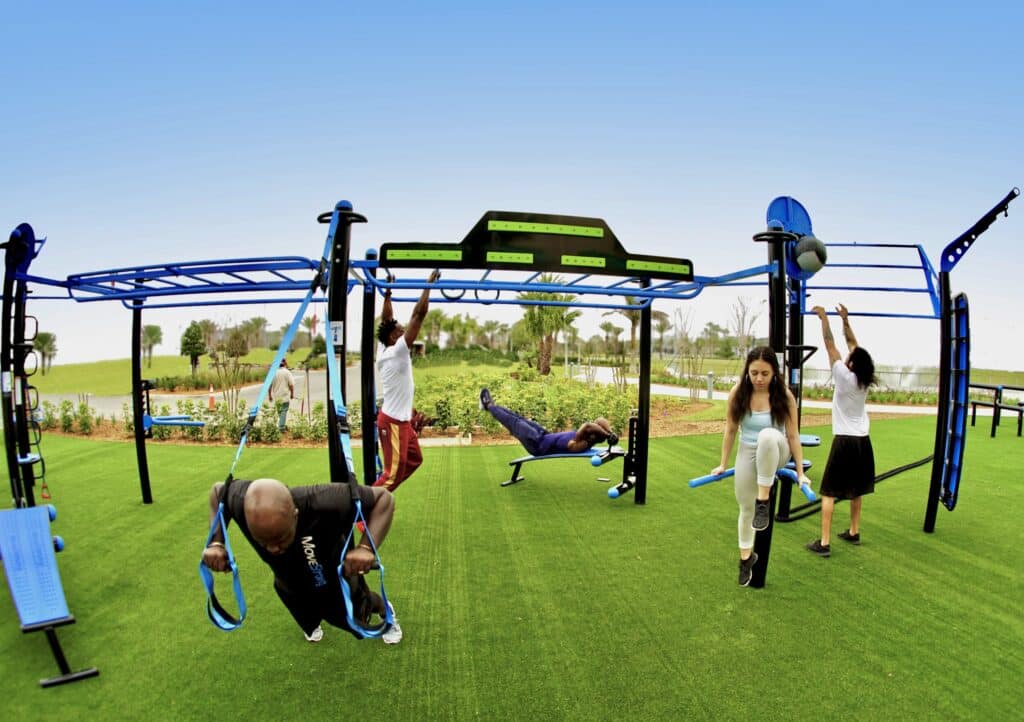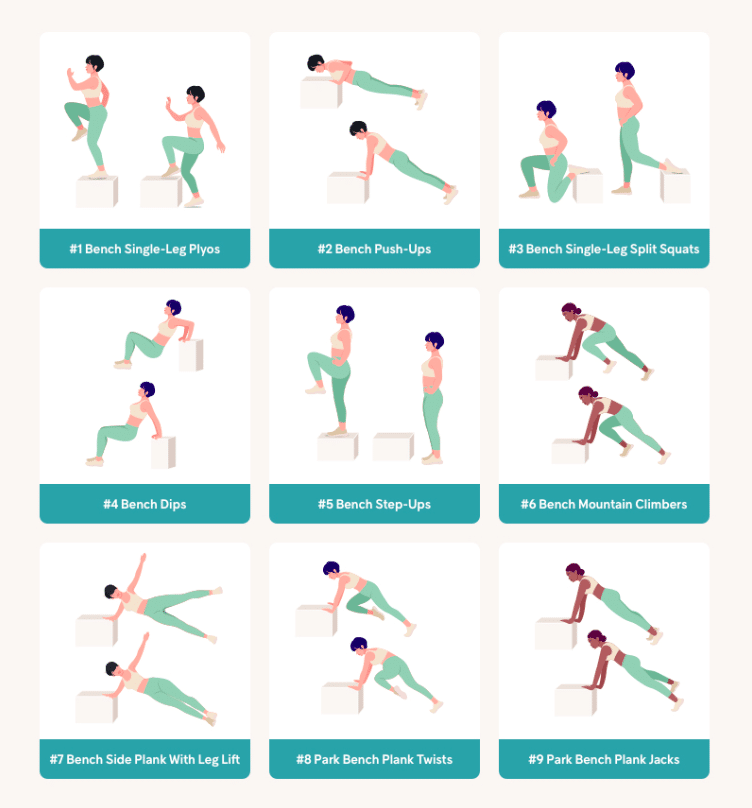As important as an outdoor bodyweight workout is, enrolling on a gym session can often seem like a luxury we can’t always indulge in. However, true physical fitness isn’t confined to gym equipment. It thrives on the endless opportunities presented by our bodies and the great outdoors.
Outdoor bodyweight exercises embody this philosophy, offering a mix of convenience, effectiveness and the refreshing embrace of nature. These routines go beyond just building strength or stamina; they’re about reconnecting with ourselves and the natural world, breaking through barriers and emerging as individuals both physically and mentally.
READ ALSO: 11 Tips for Outdoor Running You Should Try in 2024.
What Are Outdoor Body Weight Workout?

Outdoor bodyweight exercises consist of a range of movements that utilize the resistance provided by one’s body. They can be done in settings such as your peaceful backyard or a picturesque local park.
The appeal of these workouts lies in their simplicity and effectiveness in achieving fitness goals without the need for any equipment. Whether your aim is to lose weight, build muscle or improve health, outdoor bodyweight routines offer an approach suited to different fitness objectives.
These exercises leverage the elements and diversity of environments to create an engaging workout experience that cannot easily be replicated indoors. From pull-ups on a tree branch to lunges across a grassy park area, the different terrains and surroundings not only increase the physical challenge but also keep both body and mind motivated and focused.
Furthermore, outdoor bodyweight workouts emphasize movement technique and form. Practitioners are encouraged to pay attention to the quality of their movements, promoting efficiency and reducing the risk of injuries.
This focus on execution ensures that each workout is more than just going through the motions but, about moving purposefully with mindfulness.
Bodyweight exercises are simple ways to stay fit. They are efficient and connected to the wonders of nature. Body weight workout serves as a testament that real strength and fitness can be achieved by anyone, anywhere, without the need for a gym membership.
Related: 10 Effective Outdoor HIIT Workouts: Transform Your Fitness
Top 10 Outdoor Body Weight Workouts
Below is a list containing the top ten outdoor body weight workouts. They make it very easy for one to transform any park, backyard, or open area into a fun fitness wonderland.
Each is designed with specific goals in mind, ranging from adding more muscle mass to conditioning your heart—all of which means, no matter what your fitness level is, there’s definitely a great workout waiting. Embrace liberty, embrace the challenge, and let’s get to know from nearby us the energy that comes from moving our bodies in the open sky.
1. Pull-Ups, Burpees, and Squats Circuit:
Begin with five sets of 10 pull-ups (find a thick, low-lying tree branch), followed by 20 up-downs for a full cardio and strength combo, and close with 30 squats for the legs. The circuit tests stamina, strength, and determination.
2. Sprint and Leg Strength Routine:
After 100m sprints, pair them with 50 lunges, 50 step-ups on a bench or stair, and 50 mountain climbers, and follow that with a 400m slow-paced recovery run. Do it three times to improve overall cardiovascular capacity and power in the legs.
3. Ascending and Descending Reps Challenge:
This is alternating reps of 100 squats and 25 push-ups, then 75 squats and 50 push-ups, going down the line. An endurance-strength workout that progressively improves general strength.
4. Core Strengthening Circuit:
Four sets of 15 V-ups, 15 crunches, a 30-second hollow hold, and 30 hollow rocks will work all core muscles to improve stability and strength.
5. Full Body Endurance Test:

Get a timer set at 10 minutes and do 30 crunches, 30 Russian twists, 20 reverse crunches, and 30 seconds of planks (centre, left, right) on a cycle until the timer stops. This shall check and improve your endurance level plus core strength.
6. Unilateral Leg Work:
Unilateral Bulgarian split squats and pistol squats help derive strength and flexibility in both legs so as to address muscle imbalances and overall leg function.
7. Upper Body Press Variants:
Some push-up variants like diamond, wide, and clapping strengthen the upper body by linking the chest, shoulder, and triceps muscles one at a time.
8. Dynamic Squat Variations:
Jump squats, goblet squats, and Kossack squats can be included to improve your lower body with additional strength and flexibility in the program.
9. Agility and Coordination Drills:
Simple agility training drills like lateral hopping and forward-backwards sprints are helpful in improving simple balance, coordination skills, and good work on cardiovascular fitness.
10. Cool Down and Stretch:
Never underestimate the importance of cooling down and stretching to help recovery and flexibility in preparation for the next challenge.
Related: 15 Best Leg Workout Exercises To Try Out (Guide On How To)
Advantages and Disadvantages of Outdoor Body Weight Workout

Outdoor bodyweight workouts offer a unique fitness approach that combines minimal equipment convenience with the inherent benefits and challenges of exercising in the natural environment. Here’s a look at some of this fitness method’s key advantages and disadvantages:
Advantages
- Convenience and Accessibility: One of the most significant advantages of outdoor bodyweight workouts is their convenience. They require no gym membership or specialized equipment, making it easy for anyone to get started anywhere, anytime.
- Variety and Creativity: The outdoors provides a natural playground that can inspire variety and creativity in your workouts. From park benches for dips to hills for sprints, the environment itself offers numerous opportunities to vary exercises and keep workouts interesting.
- Mental Health Benefits: Exercising outdoors has been shown to reduce stress, enhance mood, and improve mental well-being, partly due to the exposure to natural light and surroundings.
- Challenge and Adaptability: Outdoor conditions such as uneven terrain and natural inclines add a unique challenge to workouts, forcing your body to adapt and engage stabilizing muscles more than it might in a controlled gym environment.
- Vitamin D Exposure: Working out outside provides exposure to sunlight, which is an essential source of Vitamin D, crucial for bone health, immune function, and mental health.
SEE ALSO: 7 Exercises That Increase Blood Flow To The Groin
Disadvantages
- Weather Dependence: One of the main disadvantages of outdoor workouts is their dependence on weather conditions. Extreme heat, cold, or rain can hinder your ability to exercise outside, affecting consistency and potentially leading to interruptions in training.
- Safety Concerns: Depending on the location, there might be safety concerns to consider, such as traffic, uneven or slippery surfaces, and personal security, especially in secluded or poorly lit areas.
- Limited Equipment: While the lack of equipment is often seen as an advantage for its simplicity, it can also be a limitation for those looking to perform heavy lifting or specific resistance training that typically requires gym equipment.
- Lack of Amenities: Unlike a gym, outdoor settings may lack amenities such as water fountains, restrooms, and changing facilities, which can be inconvenient for some people.
- Environmental Factors: Pollen, pollution, and other environmental factors can affect individuals with allergies or respiratory issues, making outdoor workouts less than ideal in certain conditions or locations.
Conclusion
Embracing bodyweight workouts goes beyond improving physical strength and endurance. It’s a chance to connect with nature and enjoy moving outside the gym environment. Whether you’re an athlete or starting your fitness journey, these versatile and accessible workouts are an option for enhancing your overall health and well-being.
FAQ
Can outdoor bodyweight exercises replace traditional gym workouts?
Yes outdoor bodyweight exercises can provide a rounded workout that enhances strength, endurance and flexibility to what you’d experience in a gym. Consistency and gradually pushing your limits are key.
How can I modify outdoor bodyweight exercises for beginners or those with physical limitations?
Begin with fewer repetitions and simpler variations of exercises (such as knee push-ups instead of standard push-ups) and progressively increase the challenge level. Listen to your body cues. Tailor the workout to match your fitness level.
Are bodyweight exercises effective for building muscle and strength?
Definitely, when done correctly with form and intensity, bodyweight exercises can significantly boost muscle strength and size by utilizing the resistance from one’s body weight.
What’s the best outdoor environment for bodyweight exercises?
Find a spot that’s secure, level and has some elements such as benches, stairs or low branches for diversity. Parks, beaches or even your own backyard can be options.
Can outdoor bodyweight exercises be suitable for all fitness levels?
One of the benefits of bodyweight exercises is their flexibility. They can be adjusted to suit any fitness level, whether you’re just starting out or an athlete.
